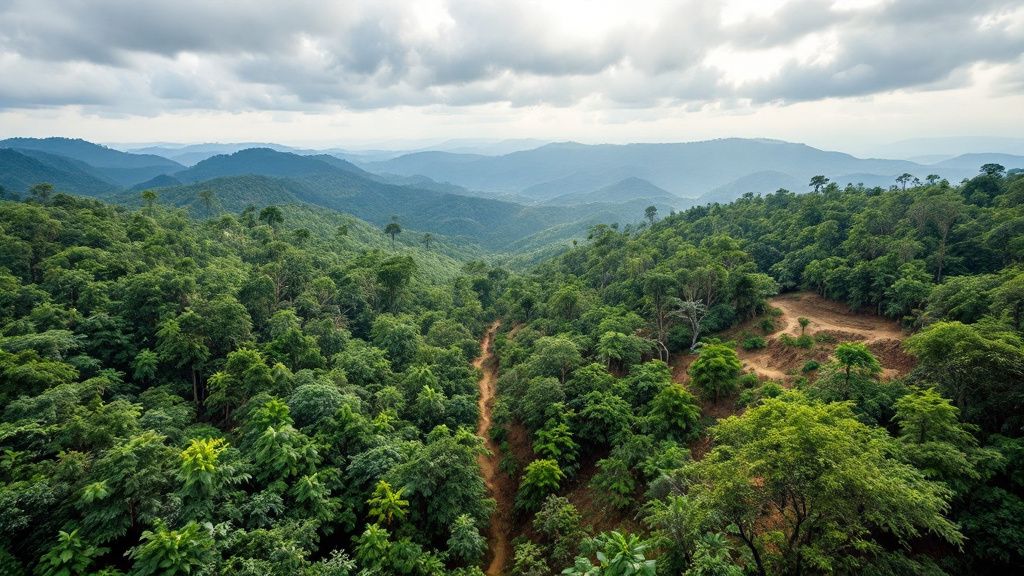The Environmental Cost of Instant Coffee
When you savor a cup of instant coffee, you might not consider the environmental trade-offs behind its convenience. The energy-intensive instant coffee production process involves roasting, grinding, and brewing massive amounts of coffee, followed by freeze or spray drying to transform it into a soluble form. This process emits significant greenhouse gases and consumes a high level of energy and water resources. Additionally, the farming of coffee beans used in this process often lacks the principles of sustainable coffee farming, which can result in soil degradation, deforestation, and loss of biodiversity. Appreciating the true environmental cost of instant coffee requires understanding these hidden impacts on our planet.

Understanding Instant Coffee Production
You may not realize it, but instant coffee requires a complex production process. It begins with selecting the right coffee beans, which are then roasted and ground. The brewing step demands large-scale, highly industrial methods to create vast quantities of liquid coffee. This is then concentrated and transformed into granules through freeze or spray drying. Each step requires energy and resources, contributing to the greater environmental cost of your daily cup.
The current trajectory of instant coffee production suggests a steady increase in environmental impacts due to rising consumer demand. This trend reflects an increase in energy consumption and resource use across the industry. As more people opt for the quick convenience of instant coffee, production intensifies, leading to heightened scrutiny on sustainable practices. The industry needs innovation to balance demand with sustainable methods to avoid exacerbating these environmental concerns.
Producers are exploring sustainable coffee farming to address these issues, though challenges remain. By prioritizing eco-friendly farming techniques, like shade-grown coffee and reduced pesticide use, it’s possible to mitigate some impacts. This exploration into sustainable practices is only beginning to touch the surface of what's needed. As a conscious consumer, understanding these processes brings insight into how you can support a healthier planet through your choices.

Deforestation and Its Consequences
Deforestation is a critical issue linked to the production of instant coffee. To meet the escalating demand for coffee, forested areas are often cleared to establish new coffee plantations. This land conversion leads to the loss of vital ecosystems and habitats, disrupting biodiversity. As forests are cut down, carbon storage capabilities diminish, significantly contributing to climate change and exacerbating the global warming crisis.
What most people don’t see about these coffee plantations is the behind-the-scenes detail: the expansive clearing of trees that provides more land for growth. This overlooked aspect drastically alters the landscape and affects local communities reliant on forest resources. The pursuit of more land for the instant coffee production process can lead to conflicts over natural resources, affecting indigenous and local populations.
Sustainable coffee farming offers a potential solution to these challenges. By implementing practices such as agroforestry, where coffee is grown beneath a canopy of trees, there's an opportunity to maintain biodiversity and reduce carbon emissions. This method supports the regeneration of forest areas, providing a sustainable alternative to the traditional clearing of land for plantations and lessening the environmental footprint of your instant coffee consumption.
Water Usage in Coffee Cultivation
Water usage in coffee cultivation is a significant environmental concern that often goes unnoticed. Growing coffee requires vast amounts of water, not only for the plants but also for processing the beans. Regions where water is scarce, the pressure on resources intensifies, affecting local ecosystems and communities. This becomes particularly concerning when sustainable practices are not implemented to conserve water and maintain environmental balance.
On one hand, advocates of traditional coffee cultivation see it as a vital economic activity that sustains livelihoods and boosts economies. They argue that coffee's commercial success justifies the extensive water use, providing jobs and economic stability in coffee-growing regions. On the other hand, environmentalists stress that excessive water consumption without sustainable practices endangers water supplies and leads to long-term environmental degradation.
The movement towards sustainable coffee farming provides a promising contrast to these challenges. Techniques like shade-grown coffee, rainwater harvesting, and efficient irrigation systems aim to reduce water consumption while maintaining crop productivity. By supporting these sustainable initiatives, you can help mitigate the environmental cost of instant coffee and encourage the industry to adopt more eco-friendly practices that ensure water conservation.
Chemical Use in Instant Coffee Production
Chemical use in instant coffee production is a critical issue impacting the environment. During cultivation, synthetic fertilizers and pesticides are often employed to boost yield and protect crops from pests. These chemicals can seep into the soil and water systems, disrupting local ecosystems and affecting biodiversity. The reliance on these substances highlights the environmental costs associated with conventional coffee farming practices and their implications.
Comparing conventional coffee farming with sustainable coffee farming shows striking contrasts. While traditional methods emphasize chemical use for immediate yield gains, sustainable practices focus on holistic approaches, minimizing chemical inputs. Techniques such as composting and biological pest control are implemented, which protect the environment and enhance soil health. This comparative analysis underscores the need for an industry shift towards eco-friendly agricultural practices.
Understanding the environmental cost of instant coffee involves recognizing how chemicals affect the entire production chain. The process extends beyond farming; during the instant coffee production process, some methods involve solvents that, if not managed properly, can lead to pollution. By advocating for and choosing sustainably farmed coffee, you can contribute to reducing chemical usage and promoting a healthier planet.

Packaging Waste and Its Environmental Impact
Packaging waste presents a pressing environmental concern within the realm of instant coffee. The sleek, convenient packaging often involves materials such as plastic and aluminum, which are challenging to recycle and contribute significantly to landfill waste. These non-biodegradable materials persist in the environment, adding to the mounting problem of pollution. The extensive use of single-use packaging highlights the underlying environmental cost tied to the daily convenience of enjoying instant coffee.
One of the main challenges in addressing packaging waste is the difficulty of recycling complex composite materials used in instant coffee products. This issue can be tackled by adopting sustainable packaging solutions, such as biodegradable or compostable materials that provide the necessary barrier properties while reducing environmental impact. Encouraging companies to innovate and invest in eco-friendly packaging is part of the solution, allowing you to enjoy instant coffee with a clearer conscience about its impact on the planet.
Additionally, sustainable coffee farming aligns well with reducing packaging waste, as it often involves a systematic approach to holistic sustainability practices. By choosing brands that emphasize eco-conscious packaging and production methods throughout the instant coffee production process, you help promote a culture of environmental responsibility, ultimately striving for a more sustainable future.

Sustainable Alternatives to Instant Coffee
Sustainable alternatives to instant coffee are gaining traction as consumers become more aware of environmental impacts. One option is choosing freshly brewed coffee using reusable filters and organic, shade-grown beans. This not only supports sustainable coffee farming but also reduces the need for resource-consuming instant coffee production processes. By opting for locally sourced beans, you contribute to minimizing the carbon footprint involved in transportation and distribution.
Exploring other brewing methods like French press or pour-over can offer a satisfying flavor experience while supporting sustainability. These methods encourage a slower, more mindful coffee-making ritual, allowing you to appreciate the nuances of fresh, high-quality coffee. The absence of disposable packaging and single-use filters further reduces environmental waste, aligning with your eco-conscious choices.
To make the most of these alternatives, try incorporating fair-trade certified beans into your routine. This strategy ensures that you support ethical practices, giving back to the communities that grow your coffee. By prioritizing fair-trade and environmentally friendly options, you play an active role in promoting a sustainable coffee culture that respects both the planet and its people, providing a better alternative to traditional instant coffee.
 Ratio Eight
Ratio Eight
 Ratio Six
Ratio Six
 Ratio Four
Ratio Four
 Compare Machines
Compare Machines







